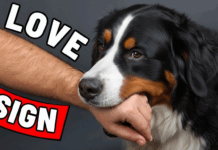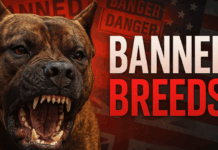Last Updated on October 7, 2022 by Dogs Vets
5 Tips to Help Calm Your Anxious Dog
It is absolutely important to consult your veterinarian if your pet is experiencing any medical problems, as well as before making any changes or adding any type of medication to your pet’s health regimen.
Every year, up to 40 million Americans suffer from anxiety, but did you know that your pet could be suffering from the same condition?
This is due to the fact that dogs, like humans, experience emotions. As a result, dogs are susceptible to experiencing feelings of anxiety as well.
What Is the Best Way to Tell if My Dog Is Anxious?
Although anxiety in dogs is real, it is possible for owners to be surprised when they notice signs of anxiety in their pets.
Your dog’s anxiety can manifest itself in a variety of ways, depending on how severe his or her condition is.
Here are some warning signs to keep an eye out for:
Mild fearful behaviors such as trembling, tail-tucking, hiding, reduced activity, and lack of movement are common.
- Panic manifests itself in the form of panting and pacing.
- Constipation and diarrhea are symptoms of negative nervous system activity.
- They are biting and licking themselves, causing lesions on their own bodies.
What has caused my dog to become anxious all of a sudden?
There can be a variety of factors contributing to your dog’s sudden onset of anxiety.
Anxiety Associated with Separation
Dog separation anxiety is the most common type of anxiety experienced by dogs. Some dogs may experience stress and excessive distress if they are left alone for an extended period of time.
If you have a history of abandonment or have been left alone for long periods of time without company or food, you may be suffering from this condition.
Having multiple owners throughout a dog’s lifetime may also cause significant separation anxiety in the animal.

Deprivation on a social level
Dogs who have experienced social deprivation at a young age may suffer from behavioral problems later in life.
If your dog becomes agitated and fearful when you remove him or her from his or her familiar environment at home, consult your veterinarian.
If your dog was deprived of social and environmental interaction while still a puppy, he or she may experience anxiety when in unfamiliar surroundings.
Anxiety that is triggered
When dogs are placed in situations that remind them of traumatic experiences they have had in the past, they may also experience anxiety.
It’s possible that your dog will bark at a person who reminds them of someone who has abused them in the past, for example.
In a similar vein, your dog may be fearful of veterinarians as a result of a traumatic operation that occurred in the past.
As distressing as it may be to observe these behaviors in your pets, there are a variety of treatment options available to help reduce the anxiety levels of your dogs’ companions.
Here are 5 Tips to Help Calm Your Anxious Dog
There are many ways to help your dog calm down, including giving it exercise, massaging, and CBD oil.
If you’re worried about your dog’s anxiety, try one or all of the tips in this article. If none of these methods seem to help, you can always try another one!
Here are 5 tips to calm your anxious dog that will surely help. These tips will help you make your dog more comfortable around you.
#1. Exercise Your Dog
If your dog is overly anxious, one of the best ways to ease the situation is to exercise it. Whether you go for walks or run in a dog park, exercise will help reduce the anxious feelings your dog feels.
The key is to start small and gradually increase the time you leave your dog alone.
Be sure to monitor their behavior and take steps to correct any issues that may arise. This way, your dog will learn to deal with stress and anxiety.
When working with an anxious dog, you should begin small and gradually work your way up to more difficult activities.
The key is to make each exercise easy and rewarding for both you and your dog. This will also reinforce the behavior that you are trying to achieve.
You can then work up to more challenging exercises and continue this process until your dog is completely obedient and calm. If you cannot get your dog to calm down at the start of the exercise, repeat it later.
#2. Massage Your dog
One way to soothe an anxious dog is to gently massage its head and butt. The head is often the first part of the body that dogs will display for petting.
Start by massaging this area with your hands, moving the hand up the dog’s body, and then returning to the same spot.
A simple, soothing massage will soon calm your dog down. For best results, make sure to massage your dog in a quiet area of the house.
When giving a massage, keep in mind that your dog may not respond to your massage technique. Watch its body language during the massage.
If it begins to move away, you probably shouldn’t press too hard or continue. It will be much easier to get your dog to relax if you use gentle strokes instead of vigorous, firm pressure. Remember to never push your dog or force your way into the dog’s body.
#3. Calming Coats/T-Shirts for dogs
Using calming coats/t-shirts for dogs is a great way to help your pet calm down in various stressful situations.
The AKC’s Calming Coats are made to apply constant pressure to your pet’s torso, making it comfortable to wear them in any situation.
The AKC Calming Coat is available in three colors and is machine washable.
The calming vest also has a calming effect on your pet and is an excellent choice if your dog is anxious.
Thundershirts, also known as calming coats and t-shirts, help calm your dog during loud noises.
These vests work by applying gentle pressure to the dog’s torso, which can be helpful in stressful situations like thunder.
Thundershirts are the best-known calming vests, but the American Kennel Club Anti-Anxiety Coat is an alternative that is less expensive and has lower ratings.
#4. CBD oil for dogs
How to use CBD oil for dogs to calm an anxious dog is a common question. There are many different types of CBD oil, and the amount to be given will vary based on the size of the dog and its weight.
You can also consult your veterinarian for specific instructions.
CBD oil dosage can be as low as a few milliliters per day or as high as several grams per day. The amount you give will depend on the strength of the CBD oil you use.
There are two main types of CBD oil for dogs. Full-spectrum CBD oil is available in a variety of flavors.
Coconut oil is great for your dog because it is comprised of 90% saturated “good” fats.
MCT oil is also antibacterial and has anti-inflammatory properties, and full-spectrum CBD oil contains cannabinoids, terpenes, flavonoids, and fatty acids. These products have a mild, earthy taste.
#5. Alternative Therapies for dogs
Medications for anxiety in dogs can often be an effective solution, but they do have side effects and are not appropriate for all dogs. It is better to try alternative therapies for your dog to calm anxiety.
Medications for anxiety in dogs should be thought of as a toolbox, not a magic wand.
In addition to alternative therapies, your veterinarian may prescribe an SSRI, or selective serotonin reuptake inhibitor, or prescribe to use natural products to treat your dog’s anxiety.
-
Herbal remedies
Herbal remedies are a natural way to soothe an anxious dog. Various homeopathic remedies can help, including Bach’s Rescue Remedy, a natural blend of lavender, sage, and sweet marjoram.
In addition, you can also rub a tincture of St. John’s Wort on your dog’s ears or thigh area. This remedy is a safer alternative to anti-depressants.
-
Pets in Need of Rescue Remedy
Rescue Remedy is a homeopathic remedy for humans that is part of the Bach homeopathic line of remedies.
Homeopathy was established more than 200 years ago and is widely practiced in Europe and England. Every remedy is based on the principle of similarity, and it makes use of plants and flowers in all their forms.
Remedy for Emergencies Pet is a blend of five different Bach Flower Remedies that work together to provide stress reduction.
It is completely risk-free to use on your canine companion. You simply add 2-4 drops to their drinking water, and they’re good to go.
Additionally, a spray is available for use on pet bedding and toys, as well as on the ground. Keep in mind that there are other homeopathic remedies that can be used on pets to treat specific issues, such as excessive barking, intolerance toward strangers, or the loss of an owner.
-
Supplements
There are dog treats available that contain beneficial supplements that have been shown to reduce anxiety. Some contain ginger as well, which can be beneficial for people who have sensitive stomachs.
These are frequently recommended for the treatment of general and travel anxiety.
If you discover that the treatments listed above are ineffective for your dog’s anxiety, it is best to consult with your veterinarian. For those suffering from separation anxiety or destructive behavior, there are a number of prescription medications available that may be of assistance.
Questions People Are Asking
What are the possible side effects of calming dog treats?
Calming Dog Treats or sleep chews are easier to get our pets to eat, but if they are consumed in large quantities, they might cause changes in the sodium levels in the blood.
It is possible to experience symptoms such as increased thirst or more serious nervous system indicators such as agitation, tremors, and even seizures if salt levels are excessively high in the blood.
How long does it take for calming Dog Treats to take effect?
How long does it take for them to take effect? These should be administered between 30 and 90 minutes prior to a stressful occasion. Calming Bites are effective for approximately 4-8 hours after administration.
Do calming treats induce sleepiness in dogs?
Calming snacks may have a sedative or drowsy effect.
Consider purchasing calming dog treats that have been designed or recommended by a veterinarian, that have undergone testing to validate the contents and potency labeling, and that utilize transparent and high-quality production practices.
Which dog breeds have the most anxiety?
Fearfulness was most prevalent among Spanish water dogs, Shetland sheepdogs, and mixed breed dogs. Dread of surfaces and fear of heights, in particular, were particularly prominent in rough collie and mixed breed dogs. Additionally, large and small breeds differed in their anxiety-like responses.
See also: accessories for your puppy’s daily needs
What kind of cryptocurrency has a dog symbol?
For a considerable amount of time, the consensus was that Dogecoin was the greatest dog-themed cryptocurrency available on the market.
However, this swiftly changed with the advent of Shiba Inu and other canine-themed cryptocurrencies.
Even if Dogecoin’s popularity is at an all-time high, there are a number of other canine-themed cryptocurrencies now dominating the market.
Bitcoin wallet is also very popular and is used to store and preserve cryptocurrencies.
Facts Check
We hope you enjoyed this article… What are your thoughts on 5 Tips to Help Calm Your Anxious Dog?
Рleаse feel free to share with us in the comments section below!
![5 Tips to Help Calm Your Anxious Dog [Symptoms & Solution] 5 Tips to Help Calm Your Anxious Dog [Symptoms & Solution]](https://dogsvets.com/wp-content/uploads/2022/04/Screenshot-2022-04-26-at-12.00.02-AM-696x390.png)
















